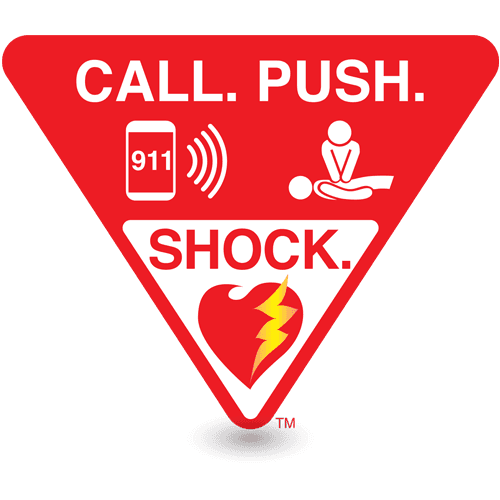
If helping someone in sudden cardiac arrest sounds overwhelming to you, you’re not alone.
Sudden Cardiac arrest – which can happen to anyone, anywhere, anytime – is a leading cause of death in the U.S. About 356,000 people experience one each year, and as many as 80% die before reaching the hospital. Frustratingly, many don’t survive because they don’t receive immediate medical attention. Too many times, emergency responders arrive to a victim who’s gone too long without treatment.
It doesn’t have to be this way. Bystanders – like you – can play a critical role in helping save a life. In fact, bystanders (non-medical professionals) are key to the cardiac arrest chain of survival.
To get started, remember this simple three-step approach: Call.Push.Shock.™
Let’s break it down.
1. Call
If a person collapses, is unresponsive, isn’t breathing, and has no pulse, they’re likely in cardiac arrest. Their heart has stopped pumping blood to the body, starving the brain and other organs of oxygen and nutrients. The brain will begin to die within a few minutes unless its oxygen supply is restored.
Call 911 immediately. Provide your location and briefly describe what’s happened. Emergency dispatchers are trained to ask you the right questions. Put your phone on speaker mode so you can communicate with the dispatcher as you assist the victim.
2. Push
It’s time to put your hands to work.
Hands-only CPR (chest compressions) is highly effective on adults and teens in cardiac arrest.
It’s important to continuously provide chest compressions during cardiac arrest because your hands take the place of the victim’s heart in pushing blood through their body. Here’s the basics:
Push hard and fast in the center of the chest.
Make sure each chest compression is at least two inches deep.
Aim for 100-120 compressions per minute.
A more detailed description of how to perform chest compressions is here.
3. Shock
If an automated external defibrillator (AED) is available, use it.
An AED is a small portable device that’s specially designed with bystanders in mind. It delivers electrical pulses that can shock a heart in cardiac arrest back into a normal rhythm.
An AED can be used without training. Once the device is switched on, an automated voice provides step-by-step instructions. The machine analyzes the victim’s heart rhythm and will only deliver a shock if one’s needed.
It’s important to continue chest compressions while using an AED. However, you’ll need to stop touching the victim while the AED delivers a stock. The device will tell you when it’s time to resume compressions and if additional shocks are needed.
Continue to follow the AED voice commands until emergency responders arrive.
You’ve done it!
That’s the Call.Push.Shock.™ method. Just remember the basics:
- Call 911
- Push hard and fast in the center of the chest
- Use an AED if one’s available
By following these steps, you can increase a cardiac arrest victim’s chance of survival by double or triple. When immediate defibrillation with an AED occurs it may increase it up to nearly 75%.
At Starting Hearts, we can provide you with specific training for making a life-saving difference.
Contact us for more information: info@startinghearts.org
Alex Alcon is a registered nurse and healthcare writer in North Carolina.
